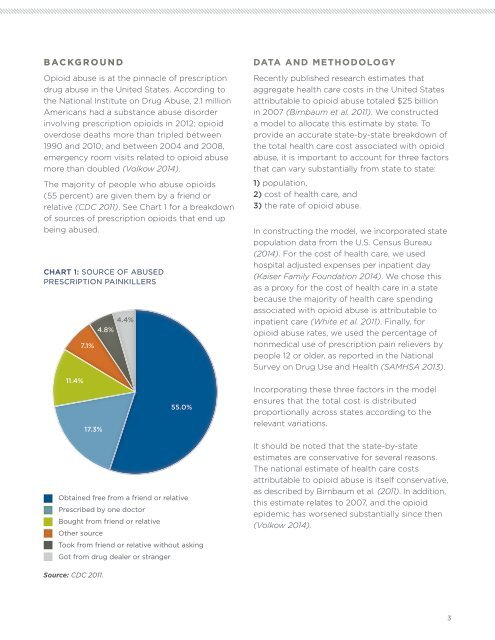The Economic Consequences of Opioid Addiction in America
The Economic Consequences of Opioid Addiction in America
The Economic Consequences of Opioid Addiction in America
Create successful ePaper yourself
Turn your PDF publications into a flip-book with our unique Google optimized e-Paper software.
BACKGROUND<br />
<strong>Opioid</strong> abuse is at the p<strong>in</strong>nacle <strong>of</strong> prescription<br />
drug abuse <strong>in</strong> the United States. Accord<strong>in</strong>g to<br />
the National Institute on Drug Abuse, 2.1 million<br />
<strong>America</strong>ns had a substance abuse disorder<br />
<strong>in</strong>volv<strong>in</strong>g prescription opioids <strong>in</strong> 2012; opioid<br />
overdose deaths more than tripled between<br />
1990 and 2010; and between 2004 and 2008,<br />
emergency room visits related to opioid abuse<br />
more than doubled (Volkow 2014).<br />
<strong>The</strong> majority <strong>of</strong> people who abuse opioids<br />
(55 percent) are given them by a friend or<br />
relative (CDC 2011). See Chart 1 for a breakdown<br />
<strong>of</strong> sources <strong>of</strong> prescription opioids that end up<br />
be<strong>in</strong>g abused.<br />
CHART 1: SOURCE OF ABUSED<br />
PRESCRIPTION PAINKILLERS<br />
11.4%<br />
7.1%<br />
17.3%<br />
4.4%<br />
4.8%<br />
55.0%<br />
Obta<strong>in</strong>ed free from a friend or relative<br />
Prescribed by one doctor<br />
Bought from friend or relative<br />
Other source<br />
Took from friend or relative without ask<strong>in</strong>g<br />
Got from drug dealer or stranger<br />
DATA AND METHODOLOGY<br />
Recently published research estimates that<br />
aggregate health care costs <strong>in</strong> the United States<br />
attributable to opioid abuse totaled $25 billion<br />
<strong>in</strong> 2007 (Birnbaum et al. 2011). We constructed<br />
a model to allocate this estimate by state. To<br />
provide an accurate state-by-state breakdown <strong>of</strong><br />
the total health care cost associated with opioid<br />
abuse, it is important to account for three factors<br />
that can vary substantially from state to state:<br />
1) population,<br />
2) cost <strong>of</strong> health care, and<br />
3) the rate <strong>of</strong> opioid abuse.<br />
In construct<strong>in</strong>g the model, we <strong>in</strong>corporated state<br />
population data from the U.S. Census Bureau<br />
(2014). For the cost <strong>of</strong> health care, we used<br />
hospital adjusted expenses per <strong>in</strong>patient day<br />
(Kaiser Family Foundation 2014). We chose this<br />
as a proxy for the cost <strong>of</strong> health care <strong>in</strong> a state<br />
because the majority <strong>of</strong> health care spend<strong>in</strong>g<br />
associated with opioid abuse is attributable to<br />
<strong>in</strong>patient care (White et al. 2011). F<strong>in</strong>ally, for<br />
opioid abuse rates, we used the percentage <strong>of</strong><br />
nonmedical use <strong>of</strong> prescription pa<strong>in</strong> relievers by<br />
people 12 or older, as reported <strong>in</strong> the National<br />
Survey on Drug Use and Health (SAMHSA 2013).<br />
Incorporat<strong>in</strong>g these three factors <strong>in</strong> the model<br />
ensures that the total cost is distributed<br />
proportionally across states accord<strong>in</strong>g to the<br />
relevant variations.<br />
It should be noted that the state-by-state<br />
estimates are conservative for several reasons.<br />
<strong>The</strong> national estimate <strong>of</strong> health care costs<br />
attributable to opioid abuse is itself conservative,<br />
as described by Birnbaum et al. (2011). In addition,<br />
this estimate relates to 2007, and the opioid<br />
epidemic has worsened substantially s<strong>in</strong>ce then<br />
(Volkow 2014).<br />
Source: CDC 2011.<br />
3

















